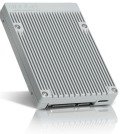Along with the long-awaited iPad Mini announcement today,Apple revealed what it called its Fusion Drive,which combines the high performance of NAND flash memory with the storage capacity of a hard disk drive(HDD).
The Fusion Drive will be available in the new iMac and Mac Mini desktops.Apple's OS X operating system and pre-installed applications will run on the SSD by default,while documents and media will run off the hard disk drive.
The new Fusion Drive combines a massive 128GB of multi-level cell(MLC)NAND flash capacity with either a 1TB or a 3TB hard disk drive,but the two media appear as a single storage volume.With 128GB of NAND flash memory,this hybrid offering puts Apple ahead of the competition.
Apple claims the Fusion Drive offers performance similar to a pure solid-state drive(SSD),but with the mass storage capacity and lower cost of a hard disk drive.
Apple did not respond to a request for additional information about the Fusion Drive at deadline.
 Apple is likely using flash technology it acquired when it purchased Anobit,such as this Anobit Genesis 2 T-Series SSD.
Apple is likely using flash technology it acquired when it purchased Anobit,such as this Anobit Genesis 2 T-Series SSD.
Based on the amount of flash capacity offered by Apple,industry analysts do not believe its Fusion Drive is a hybrid drive,which combines flash and spinning disk in a hard drive form factor.Seagate sells the most popular version of a hybrid drive on the market--the Momentus XT,which has 8GB of single-level cell(SLC)NAND flash along with up to 750GB of spinning disk capacity.
Western Digital has also announced a thin hybrid drive for ultrabooks with up to 500GB of capacity.
The Fusion Drive's 128GB of flash capacity would require a great deal of space inside an HDD form factor,said Fang Zhang,an analyst with research firm IHS iSuppli.
"I think you can call it a hybrid solution,"Zhang said."Basically you have two drives:one SSD and one HDD,but with a controller and software that can manage where the data goes."
"Anobit is their source for SSD,and the HDD is still from Seagate,"Zhang continued."The controller could come from Marvell."
Apple was already the industry's largest NAND flash consumer when,in December 2011,it acquired Israeli-based SSD maker Anobit.
Prior to the acquisition,Anobit had been focused on making flash storage products for data center use manufactured out of consumer-grade NAND flash memory.
Anobit's most valuable intellectual property--its secret sauce--is its firmware that it calls Memory Signal Processing(MSP),a type of error correction code(ECC).Like other ECC technology,Anobit's MSP gives it a means of addressing the reliability issues that arise as solid-state memory components shrink in size.
The smaller NAND flash systems get,the more chance there is that electrons will pass through thin cell walls and create data errors.
Anobit has produced two generations of Genesis SSD technology.
The purchase of Anobit addressed several issues for Apple.For one thing,it freed the company from dependency on flash component makers such as Samsung and Intel,which lead the market in NAND flash production.And,it gave Apple access Anobit's ECC software,enabling the company to use the least expensive NAND flash while still maintaining high performance and endurance levels.
If Apple is using Anobit SSD with Seagate HDD,it would not be a first.
Laptops that sport two drives--a high-capacity hard drive and a low-capacity solid-state"cache"drive--are already shipping and are expected in droves with the release of ultrabooks.But ultrabooks tend to have smaller"cache"SSDs with 20GB to 50GB of capacity,so Apple's 128GB SSD is enormous by comparison.
Also,cache SSDs come in several sizes.Most are 2.5-in.mini-SATA drives,just like a typical laptop hard drive.
The cache SSD works in the same way as Seagate's Momentus XT:The operating system and the most frequently used applications are loaded from the flash memory,while files and other less frequently used data are stored on the HDD.The result is a lower-cost computer with similar performance to a system with just a pure SSD.
Intel,Micron and OCZ are putting out cache SSDs,while Lenovo,Asus,Acer,Hewlett-Packard and Dell are beginning to build laptops and ultrabooks that use them.For example,a number of Lenovo's ThinkPad and ThinkPad Edge notebooks support cache SSDs.
The Asus Zenbook UX32VD ultrabook combines a hard drive that holds up to a 500GB with a 24GB SSD.In fact,according to Intel's specifications,in order to be called an ulatrabook,a device must use either a cache SSD or a full-size SSD to achieve the required level of performance.





